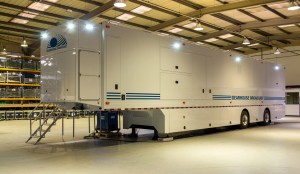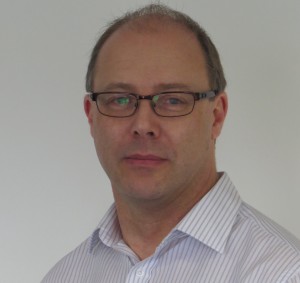SVG Europe Sit-Down: Gearhouse Broadcast’s Martin Paskin on 4K progress and the future of remote production
News of Gearhouse Broadcast’s new OB unit – Columbus – in the US has generared many column inches in the trade media over the last few weeks. Designed to be versatile and with quick configurability for live production, it has the ability to switch configurations at will and handle native 4K, along with 3G or HD signals simultaneously. Although destined for the US market, there is a European connection with the vehicle being built by specialist coachbuilder A Smith of Great Bentley (ASGB Ltd), under the oversight of Gearhouse’s System Integrations team. With that in mind, the new truck was an obvious place to start our conversation with systems integration manager Martin Paskin.
The recent talk has been all about Columbus – your new 4K truck in the USA. What were the challenges you faced – and overcome – in such an innovation?
Integrating a new unit always take a lot of time and there’s always challenges to overcome when you’re implementing all of the latest innovations into a truck. It’s the first mobile truck in the U.S. to feature a full 4K monitor wall, “one button” hydraulic deployment and integrated RF. Putting all of this – and the rest of the truck’s infrastructure – into a single unit is a challenge so we integrated it using Gearhouse’s systems integration in the UK, using their expertise to overcome this.
One of the biggest challenges in building a new truck is in the way the industry now operates. The main broadcast is no longer the only one. With Columbus, we wanted to make sure we could easily produce the multiple language broadcasts and increasingly, separate online productions that are needed by broadcasters. So, the truck features two split production areas so we can produce a main cut and a sub cut for any programme at the same time.
That’s the US. What do you see as the progression of 4K in Europe?
There appears to be very little interest in 4K outside of sports production. Those that are talking to us about 4K are only doing it to future proof their facility as most do not have any programme requirement for 4K. Many customers are still not ready to jump into building IP infrastructures for live production due to the lack of interoperability between the various manufacturers. We are also now seeing customers ask for HD infrastructures which are 12G SDI capable, and we are expecting to see new 12G SDI products launched this year at NAB. There is generally more interest in building facilities which are HDR capable, as it is widely recognised that HDR can provide a better viewing experience without the expense of building a 4K facility.
Earlier this year you became UK distributor of Aperi technology. What does this mean for your customers?
True virtualised video processing platform in IP. The technology from Aperi provides a platform for running virtualised video processing. This is really exciting because we now have the capability of building a very flexible broadcast infrastructure without the constraints of point to point SDI video. The Aperi platform allows us to use a basic set of hardware with front facing SFPs which can carry many different types of off the shelf interfaces, including fibre and copper Ethernet and SDI. On to this platform we can then install apps for processing the signals which currently include SDI & ASI encapsulation, S2022/2/5/6&7, compression encoding and decoding, NAT/Firewall for routing video over IP, multiviewer, and clean hitless switching. These processing apps can be moved around the customer’s hardware when and where they are required – and can also be provided on rental model. This opens up really interesting opportunities for us to offer modern broadcast infrastructures. The platform also lends itself to build remote production facilities with a distributed architecture which can change depending on the production, venue and connectivity.
Gearhouse brought a fresh Systems Integration approach to CABSAT 2017. For those who couldn’t make the show, can you tell us more?
Whilst Gearhouse Broadcast does have an office in Qatar, this was the first time that Gearhouse Broadcast SI has exhibited at CABSAT. The Middle East is a very competitive market place, and there are many local and international systems integrators working here. Gearhouse Broadcast is able to bring together the expertise and resources from all of our global businesses, including our rental, outside broadcast and project solutions into our systems integration to offer customers in the Middle East this additional value for news and sports facilities, OB vehicles as well as installations for sports stadiums and places of worship.
Do you see the expansion of remote live production having an impact on your business?
Very little at the moment, however several of our customers are asking for our help in coming up with solutions. At the moment, there are a number of manufacturers who want to sell single vendor solutions. The value of a systems integrator is to take a step back from both the production process and the technology and to design a technical solution around the production requirements. The biggest issue is that the connectivity, and the cost of that connectivity can be different between venues. Any solution needs to take this into consideration.
But what do you see as the next innovation when it comes to IP technology?
Like the move from tape based workflows into file based workflows, building a broadcast infrastructure over IP allows us to change the way we work. Once we have the appropriate standards put in place, and we have true interoperability of SMPTE 2110, I foresee a growth in distributed and virtualised processing solely within the IP domain. Like the Aperi platform, once we have a true IP infrastructure, it will be possible to process video in various locations. This could be at a remote production, in a broadcast centre or even in a datacentre such as Amazon’s EC2 F1 platform.



